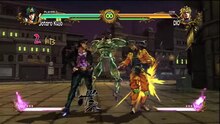Combo (video gaming)
 Play media
Play mediaJotaro Kujo performing a series of combos against Dio Brando in JoJo's Bizarre Adventure: All Star Battle.
In video games, a combo (short for combination) is a set of actions performed in sequence, usually with strict timing limitations, that yield a significant benefit or advantage. The term originates from fighting games where it is based upon the concept of a striking combination. It has been since applied more generally to a wide variety of genres, such as puzzle games, shoot 'em ups, and sports games. Combos are commonly used as an essential gameplay element, but can also serve as a high score or attack power modifier, or simply as a way to exhibit a flamboyant playing style.
In fighting games, combo specifically indicates a timed sequence of moves which produce a cohesive series of hits, each of which leaves the opponent unable or almost unable to block or otherwise avoid the following hits in the sequence.[1]
Contents
1 History
2 Other uses
3 See also
4 References
History
The use of combo attacks originated from Technōs Japan's beat 'em up arcade games, Renegade in 1986 and Double Dragon in 1987. In contrast to earlier games that let players knock out enemies with a single blow, the opponents in Renegade and Double Dragon could take much more punishment, requiring a succession of punches, with the first hit temporarily immobilizing the enemy, making him unable to defend himself against successive punches. Combo attacks would later become more dynamic in Capcom's Final Fight, released in 1989.[2]
The earliest known competitive fighting game that used a combo system was Culture Brain's Shanghai Kid in 1985; when the spiked speech balloon that reads "RUSH!" pops up during battle, the player had a chance to rhythmically perform a series of combos called "rush-attacking".[3]
The combo notion was introduced to competitive fighting games with Street Fighter II by Capcom, when skilled players learned that they could combine several attacks that left no time for the computer player to recover if they timed them correctly.[4][5][6] Combos were a design accident; lead producer Noritaka Funamizu noticed that extra strikes were possible during a bug check on the car-smashing bonus stage. He thought that the timing required was too difficult to make it a useful game feature, but left it in as a hidden one.[7] Combos have since become a design priority in almost all fighting games,[7] and range from the simplistic to the highly intricate. The first game to count the hits of each combo, and reward the player for performing them, was Super Street Fighter II.
Other uses
Many other types of video games include a combo system involving chains of tricks or other maneuvers, usually in order to build up bonus points to obtain a high score. Examples include the Tony Hawk's Pro Skater series and the Crazy Taxi games. The first game with score combos was Data East's 1981 DECO Cassette System arcade game Flash Boy.[8]
Combos are a main feature in many puzzle games, such as Columns, Snood and Magical Drop. Primarily they are used as a scoring device, but in the modes of play that are level-based, are used to more quickly gain levels. Shoot 'em ups have increasingly incorporated combo systems, such as in Ikaruga, as have Hack and Slash games, such as Dynasty Warriors.
See also
- Konami Code
Fighting game terms at Wiktionary
References
^ "The Next Generation 1996 Lexicon A to Z: Combo". Next Generation. No. 15. Imagine Media. March 1996. p. 31..mw-parser-output cite.citation{font-style:inherit}.mw-parser-output q{quotes:"""""""'""'"}.mw-parser-output code.cs1-code{color:inherit;background:inherit;border:inherit;padding:inherit}.mw-parser-output .cs1-lock-free a{background:url("//upload.wikimedia.org/wikipedia/commons/thumb/6/65/Lock-green.svg/9px-Lock-green.svg.png")no-repeat;background-position:right .1em center}.mw-parser-output .cs1-lock-limited a,.mw-parser-output .cs1-lock-registration a{background:url("//upload.wikimedia.org/wikipedia/commons/thumb/d/d6/Lock-gray-alt-2.svg/9px-Lock-gray-alt-2.svg.png")no-repeat;background-position:right .1em center}.mw-parser-output .cs1-lock-subscription a{background:url("//upload.wikimedia.org/wikipedia/commons/thumb/a/aa/Lock-red-alt-2.svg/9px-Lock-red-alt-2.svg.png")no-repeat;background-position:right .1em center}.mw-parser-output .cs1-subscription,.mw-parser-output .cs1-registration{color:#555}.mw-parser-output .cs1-subscription span,.mw-parser-output .cs1-registration span{border-bottom:1px dotted;cursor:help}.mw-parser-output .cs1-hidden-error{display:none;font-size:100%}.mw-parser-output .cs1-visible-error{font-size:100%}.mw-parser-output .cs1-subscription,.mw-parser-output .cs1-registration,.mw-parser-output .cs1-format{font-size:95%}.mw-parser-output .cs1-kern-left,.mw-parser-output .cs1-kern-wl-left{padding-left:0.2em}.mw-parser-output .cs1-kern-right,.mw-parser-output .cs1-kern-wl-right{padding-right:0.2em}
^ Jess Ragan (2006-06-15). "Playing With Power". 1UP.com. p. 3. Archived from the original on 2012-07-18. Retrieved 2011-02-25.
^ https://www.youtube.com/watch?v=ZRX7EajnUHA
^ 1up.com - The Essential 50, Part 32: Street Fighter II
^ IGN staff (2007). "The Top 100 Games of All Time!". IGN.com. Retrieved 16 June 2011.
^ "20 Things You Didn't Know About Street Fighter II". 1UP.com. 2011-03-30. Retrieved 16 June 2011.
^ ab "The making of Streetfighter II". Edge presents Retro ('The Making of...' Special). 2003.
^ John Szczepaniak, History of Japanese Video Games, Kinephanos, ISSN 1916-985X
